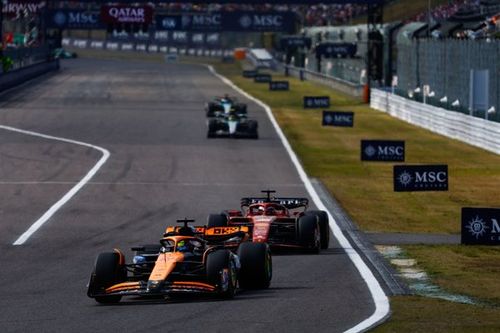McLaren had a challenging Canadian Grand Prix weekend, even without considering the late collision between teammates Lando Norris and Oscar Piastri. For the championship-leading team, it was the first race this year where neither driver finished on the podium, and the first time neither car started from the front row.
Off weekends are not uncommon even in highly dominant seasons – remember Red Bull`s tough time in Singapore during their otherwise near-perfect 2023 campaign. However, these unusual results can often be the most insightful. From a pure performance standpoint, the 2025 Canadian Grand Prix wasn`t a disaster for McLaren; they were still fighting close to the podium before the incident on lap 67. Yet, the weekend revealed potential areas where the team might struggle in the future.
Before arriving in Canada, McLaren had anticipated that Montreal`s circuit layout, characterized by long straights broken up by chicanes demanding quick changes of direction, would not play to their car`s strengths. While there`s no panic at their Woking base, the result provides a reason for cautious optimism among their competitors.
With team principal Andrea Stella`s Sunday media session dominated by questions about the drivers` collision, we need to look back to Saturday for the team`s assessment of their performance issues. Stella didn`t hide the car`s limitations on the track, acknowledging that while a better outcome might have been possible from higher grid positions, the fundamental pace wasn`t there after Piastri qualified third and Norris seventh.
Stella explained that one key issue was the car`s inability to generate sufficient grip, which was noticeable from the very first free practice session. He attributed this to the circuit`s design, which involves extensive braking and traction zones with limited sustained cornering. He stated, “even if it`s low-speed corners, there`s actually a lot of braking and traction [in Montreal]. There`s not much mid-corner phase in itself. You are either on the brakes or on the throttle, and in both conditions, we have to say that the car struggled a bit to start with.”
If the Canadian circuit represents one extreme in terms of track layouts on the F1 calendar, the Circuit de Barcelona Catalunya, where McLaren secured a dominant one-two finish just two weeks prior, sits at the other end. The high-speed, long corners of the Spanish track perfectly suited McLaren`s car, highlighting its exceptional downforce and balance, giving them a qualifying advantage of over 0.4 seconds against their nearest rivals.
Furthermore, McLaren`s strength in managing tire overheating and minimizing degradation, so evident in Spain, was less relevant in Canada. While tire management is a key trait McLaren has mastered this season and a target for other teams, Montreal`s smooth track surface meant overheating wasn`t a primary concern on Sunday.
Instead of overheating, drivers battled graining – where the tire surface shreds and forms rubber balls, reducing grip. This problem was particularly noticeable on Piastri`s front left tire during the race, although he wasn`t the only one affected.

McLaren`s relative struggles created an opportunity for rivals to capitalize. As it turned out, the same track characteristics that hindered McLaren helped Mercedes unlock significant performance from their car. Mercedes took full advantage, with George Russell winning and Kimi Antonelli achieving his first career podium in third.
Since the current regulations were introduced in 2022, one of Mercedes` main challenges has been finding a car setup that offers a good balance between low-speed and high-speed corners. This generation of cars often exhibits understeer in slow turns, and attempts to increase front downforce can lead to an unstable rear end in fast corners.
Mercedes has improved its car`s balance over the past year, but Montreal`s abundance of low-speed corners simplified the setup problem. Optimizing the car for the chicanes and the Turn 10 hairpin meant there were no significant high-speed corners elsewhere on the track to compromise performance.
Another advantage of the lack of sustained high-speed corners was easier tire temperature control. Montreal`s quick direction changes between the walls reward driver confidence and stability under braking but don`t subject the tires to the prolonged stress seen in faster corners.
Adding to this, the smooth track surface further reduced the risk of tire overheating, even with track temperatures reaching 50 degrees Celsius on race day.
Discussing their strong showing, Mercedes Team Principal Toto Wolff said, “Montreal was always good to us, it lacks the typical high-speed corners where we suffer more in the heat. That`s one, and number two is quite a smooth asphalt here, which is less abrasive and therefore less damaging to our car that suffers from rear tire degradation and overheating.”
Mercedes also used a new rear suspension layout in Montreal, which had only been previously tested in practice at Imola before being removed for the rest of that weekend. This modification was intended to address Mercedes` tire temperature weaknesses. While it likely contributed positively in Canada, it will need to be tested on a more demanding circuit to be considered a significant upgrade.
Wolff elaborated, “I think we brought the new rear geometry for the particular [tire overheating] problem that we had, the rear [tire] surface overheating, and we weren`t quite sure about the results in Imola, because they were worse than we expected. And there I think taking it off was the right thing to do, and bringing it on here, because hopefully the development direction is correct long term.”
He added that under current regulations, it`s hard to be certain about the impact of developments, and correlation with data has been particularly difficult for Mercedes. He also stressed the influence of factors like track layout and asphalt, concluding that “there is never one magic solution that makes the car go from a, let`s say, best-case-podium car to a dominant winner.”
George Russell commented on the result, stating, “We`re under no illusions that this really suited the strengths of our car the same way as it did last year. But for the majority of the circuits, we know it`s a bit of a challenge, and that`s why this is the first weekend both of us are on the podium. But it`s great to see that when we get that chance, we take it.”
In summary, Sunday`s result is likely a temporary dip for McLaren rather than a significant turning point in the championship. However, it serves as proof that unexpected results are still possible throughout the rest of the 2025 season.









